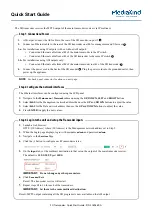
3 - 1
SECTION 3
CIRCUIT DESCRIPTION
3-1 RECEIVER CIRCUITS
ANT-SW UNIT
Antenna switching relays (RL51, 61, 71, 81) select the RX
signals which are from [ANT1]–[ANT4], and the relays are
controlled by relay controller (IC11). RX signals from [ANT1]
–[ANT3] are applied to the CTRL BOARD, RX signals from
[ANT4] are applied to the RF UNIT directly.
CTRL BOARD
The CTRL BOARD has TX/RX switch which toggles the RF
path between in TX and RX.
RX signals from the ANT-SW UNIT are passed through the
TX/RX switches (RL252–254), and applied to the RF UNIT.
RF UNIT
RF UNIT contains receive circuits; from RX BPF to 2nd
RX IF AMP. The RX signals are filtered by BPFs to remove
unwanted signals and amplified, then down-converted twice
into 2nd IF signal.
The received signals from the ANT-SW UNIT and CTRL
BOARD are passed through some relays and attenuators,
then filtered by BPFs which is assigned to filter the RX
signals that desired to receive. The filtered RX signals are
amplified by RF AMPs before being applied to the 1st mixer.
• 0.03–30 MHz SIGNALS
The RX signals from the band SW (RL351) are passed
though one of the BPF or LPF. The filtered signals are
entered to the DIGISEL UNIT, and gone through or
by-passed the DIGISEL (Digital RF Selector Switch) filter.
When the DIGISEL function is activated, the RX signals
are passed through the DIGISEL SW (RL21) and narrow
bandwidth filter (D_SEL) which filters out unwanted signals
with its sharpen frequency response. The filtered signals are
amplified by the RF AMP (Q201) which recovers the insert
loss of the D_SEL filter, then backed to the RF UNIT via
DIGISEL SW (RL2).
The RX signals from the DIGISEL UNIT are applied to or
by-passed the Pre-AMP.
When the Pre-AMP1/2 is activated, the RX signals are
applied to the Pre-AMP1 (for all HF bands) or Pre-AMP2
(for 24 MHz and above) via P.AMP SW (RL1004), and the
amplified RX signals are applied to the 1st mixer (IC1051)
via the P.AMP SWs (RL1005, 1006) and LPF.
The RX signals are mixed with the 1st LO signals from
the PLL UNIT (1st LO signals are gone through LO AMPs
(Q1105, 1104, 1101) before being applied.) to be converted
into the 1st RX IF signal.
• 30–60 MHz SIGNALS
RX signals from the band SW (RL351) are passed though
one of the BPFs (Fc=50–54 MHz or Fc=54–60 MHz) to
remove unwanted signals.
The filtered signals are amplified by one of (or both of)
the Pre-AMPs (or by-passed; according to the setting).
The amplified RX signals are then applied to the 1st mixer
(Q1211, 1212) via the LPF.
The RX signals are mixed with the 1st LO signals from PLL
UNIT (the 1st LO signals are gone through LO AMP (Q1301),
HPF and LPF before being applied.) to be converted into
the 1st RX IF signal.
A portion of 1st IF signal is applied to the SCOPE UNIT via
buffer (Q1352).
The converted 1st RX IF signal is then filtered by one of 1st
IF filters on the MCF BOARDs (FI1401). Selecting of the
filter to pass is carried out by IF SW (IC1402, 1403). The
filtered 1st RX IF signal is amplified by two 1st IF AMPs
(Q1401–1403), then splitted into two before being applied
to the 2nd mixers; as a image rejection mixer (IC501,
1502). Each divided 1st RX IF signal is mixed with 2nd LO
signals from the PLL UNIT (gone through ATT, LO AMP
(Q1651), buffer (IC1651) and another buffer (IC1651)), to be
converted into the 36 kHz 2nd RX IF signal.
One of the LO signal is 90 degrees phase-shifted before
being applied to the 2nd mixer (IC1502), and the converted
2nd RX IF is 90 degrees phase-shifted too.
These converted 2nd RX IF signals are buffer-amplified
by buffer (IC1502/IC1501) and amplified by 2nd IF AMP
(IC1504/IC1503). Then the 2nd RX IF signals whose phase
is different each other are phase-shifted by the phase shifter
(IC1505), then composed by the composer (IC1505).
The composed 2nd RX IF signal is amplified by another 2nd
IF AMP (IC1506), then entered to the MAIN UNIT.
Signal
Frequency
Signal
Frequency
1st RX IF
64.455 MHz
1st RX LO
64.485–124.455 MHz
2nd RX IF
36 kHz
2nd RX LO
64.491 MHz
1st TX IF
36 kHz
1st TX LO
64.485–124.455 MHz
2nd TX IF
455 kHz
2nd TX LO
64 MHz
3rd TX IF
(*)
*; Refer to "SPECIFICATIONS."
• FREQUENCY CONFIGURATION








































